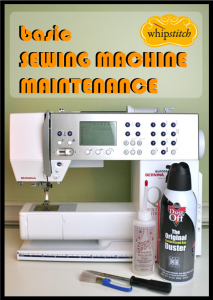 It’s lovely to know HOW to clean your machine(s), but it’s equally important to know WHEN to clean them, in order to make sure you get the most out of them and catch any issues before they become problems. Today, a sample schedule for maintaining and servicing your sewing machine and serger.
It’s lovely to know HOW to clean your machine(s), but it’s equally important to know WHEN to clean them, in order to make sure you get the most out of them and catch any issues before they become problems. Today, a sample schedule for maintaining and servicing your sewing machine and serger.
Sewing Machine cleaning and service schedule
Every new project: replace needle
Every time you sew: dust outside and tidy up beneath the machine; keep machine covered when not in use to decrease dust settling
Once a month: clean the interior of the bobbin assembly and case, the tension disks, and under the throat plate; oil all necessary parts
Once every two years: take your machine to the dealership or service center for a standard check-up and maintenance (should run you around $55-$65, depending on where you live, and is totally worth it)
Serger/Overlock cleaning and service schedule
Every time you sew: clean beneath the machine, dust off any lint, and keep the serger covered between uses
Once every two weeks: clean the interior of the machine, removing all lint and particles
Once a month: run a length of thread soaked in alcohol through the tension disks to collect any bits of fluff that your cleaning missed
Once every four months: take your machine to the dealership or service center for regular maintenance; replace cutting blades at this time, especially if you’re a heavy user
Obviously, this might not be the schedule you choose to regularly follow–I know folks who clean their machine(s) every single time they use them, either because they sew infrequently (and so the machine will be stored afterward and they want to store it in a clean and oiled state) or because they sew very often (and there is a greater accumulation of lint and dust). Either way, taking the best care of your machine that you can will help it to last longer–and that’s true of less expensive models as much as it is of fancier machines.
Last tip: use the best thread you can afford. Cheaper threads have bits of microscopic lint that come off them, which sheds all over your machine–both where you can see it and where you can’t. I used to get tons of bits of thread on my throat plate, and assumed it was fluff from the cut edge of my fabric. Turns out, it was from the thread rubbing against the thread guides, and bits of it were flying off–imagine what was inside my machine! Better-quality threads have vastly less fluff and breakage, and will not only treat the interior of your machine better, but will last longer in your sewn projects, too.
*As always, this advice is a recommendation only, and you are strongly urged to consult your owner’s manual and your service provider to learn what service schedule and maintenance techniques will work best for your machine.



Lorraine
June 28, 2012 at 5:38 pmThank you for this! I used to use the same needle over and over again for everything until I discovered ball point needles and marveled at how much better it was sewing with knits because of them so now I’ve become a needle replacing pro!
Is it okay to share this on pinterest?
Deborah
June 29, 2012 at 1:47 pmI know! There are all these different types of needle, and I think I glossed over them when I was first sewing, because I didn’t know what they were for. When I started to play around and learn how to use them, I was genuinely surprised at how much better my results looked–and how much more fun I was having! Who knew??
Please feel free to pin away!
Ginger
June 28, 2012 at 10:04 pmThanks for this series. Wish I could bring my machines to the Atlanta area to be serviced, $65 for service is a steal. In my area expect to pay closer to $100.
Deborah
June 29, 2012 at 1:46 pmWhoa, that’s crazy! I’ve heard of prices here going up to $85 for computerized machines (and sometimes sergers), but $100 seems high. If you’re ever in the mood for a road trip, come down this way and hang out at the shop while you’re machine’s at the dealership!
Tillalili
June 30, 2012 at 8:33 pmSpecialty shops in CT for Bernina charge around $135 for an overhaul. $65 is definitely a steal!
Tillalili
June 29, 2012 at 1:26 pmI have a Bernina sewing machine so I don’t know if this will apply to all sewing machines but, I find that the lint builds up under the throat plate quite easily so I clean under there often. It’s easy enough to check, and I’m sure you will be as surprised as I was to see how much lint accumulates under there and how fast, which can potentially cause stitch problems.
I’ve heard many times to change the needle every project. If that was the case I would go through at least a dozen needles a week. I use the same needle for weeks, some times months, until I see the stitches aren’t quite up to par. Needles last a long time! Personally, I think changing for every project is a waste…unless you need to change to a different size for a project.
Bernina says not to oil your machine. There’s a Bernina in the photo so I’m wondering if I should oil my machine. What do you think?
Deborah
June 29, 2012 at 1:44 pmI completely agree about the throat plate–especially with fabrics that really shed, like corduroy or minkee or something like that. I really did have so much lint at one point that my stitches got shorter because the poor feed dogs couldn’t move! So I tend to clean out under there much more often.
I used to really resist–soooo hard–changing the needle more often because I’m such a crazy cheapskate, but have found that it makes a substantial difference in my results. Not only do I get a better stitch quality–fewer skipped stitches, tighter stitches, and better tension–but a newer needle leaves a smaller puncture in my projects and I have found over time that the things I sew with a new needle wear longer and last better in the wash than the ones where I was making a needle last. Now, I admit I don’t use a new one for every little project, just every MAJOR project, so I can get the most life out of them–if I’m doing matching outfits for the children with only a few seams, I’ll use the same needle for all three, for example. But for bigger projects, like a garment for myself or a quilt, I always use a new one–it’s just funner when they glide through the fabric like butter! One rule of thumb is every 8-10 hours of sewing, which I think is more logical but harder to keep track of. I actually do go through about 4-6 needles a week, but at a cost of around $3, I think it’s worth the peace of mind.
One rule of thumb is every 8-10 hours of sewing, which I think is more logical but harder to keep track of. I actually do go through about 4-6 needles a week, but at a cost of around $3, I think it’s worth the peace of mind.
As for the oil, my Bernina is the 440, and it has a little picture of an oil can that comes up on the screen and blinks at you if you don’t oil frequently enough. I’m assuming that different models have different requirements? I don’t know very much about the 300-series that just came out–I think they’re designed to be lower-maintenance and more user-friendly, which might mean you don’t need to oil them. My Viking wasn’t meant to be oiled ever, which was so nice for me–nothing to forget to do!
Tillalili
June 30, 2012 at 8:38 pmI like your idea about 8 to10 hours for a needle. I’m going to try that out and see how it works. I don’t normally make clothing. The items I make take about an hour. I can see changing about every 8 or so projects. I also use high thread count premium cotton. It’s a lot softer and makes a ton of lint so I look under the throat plate every day just in case. I usually have to clean it too. I was surprised about that.
Thanks for all the tips….it’s fun hearing them.
PS: If you would like to see what I’m currently making, check out my Etsy shop — http://www.tillalili.etsy.com Let me know what you think.